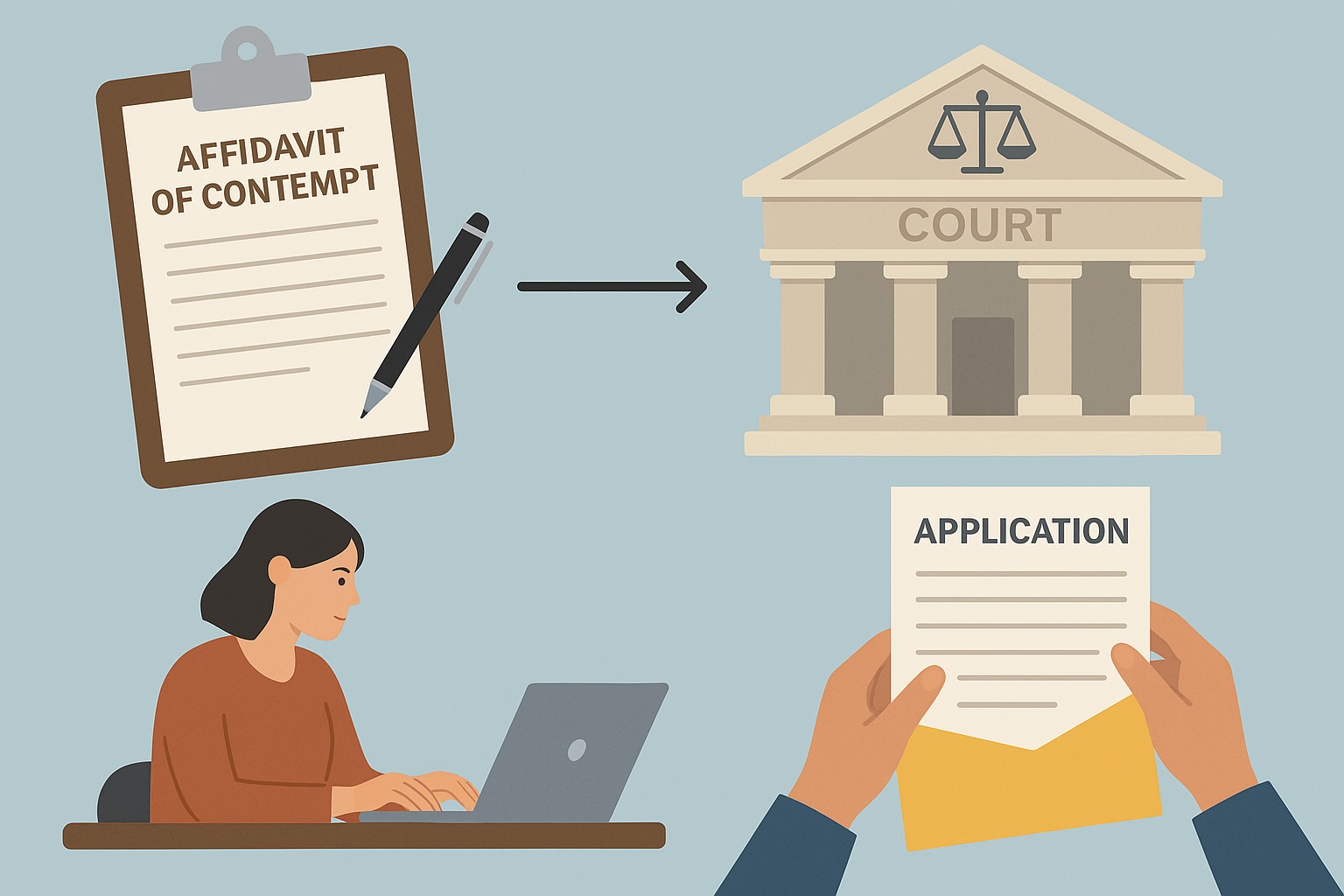How to File an Affidavit of Contempt in Ontario Court
Learn how to file an Affidavit of Contempt in Ontario when someone violates a court order. This guide walks you through the legal process, requirements, and court form you’ll need to submit.

When a person **deliberately disobeys a court order**, it’s not just frustrating—it’s a violation of the law. In Ontario, you can respond by filing an **Affidavit of Contempt**, which is part of a formal **contempt motion** before the court.
This article explains what contempt of court means, how to prove it, and how to complete the court filing using the proper affidavit.
***
### ❗ What is Contempt of Court?
**Contempt of court** occurs when someone willfully:
* Disobeys a court order (e.g., custody order, restraining order)
* Interferes with the administration of justice
* Fails to appear in court when required
If found guilty of contempt, the person can face serious consequences, including **fines**, **court costs**, or even **jail time**.
***
### 🧾 What is an Affidavit of Contempt?
An **Affidavit of Contempt** is a sworn legal document that outlines how the other party has violated a court order. It is submitted as **evidence** to support your contempt motion.
> 🖋️ It must be sworn or affirmed before a commissioner, lawyer, or notary public.
***
### 📄 Where to Find the Form
There is **no separate standard form titled “Affidavit of Contempt.”** Instead, you use:
* **[Form 14A – Affidavit (General)](https://www.ontariocourtforms.on.ca/static/media/uploads/courtforms/family/14a/flr-14a-e.pdf)**
This form allows you to describe in detail:
* What the order said
* How the respondent failed to comply
* When and how the violation occurred
* Any supporting documentation or evidence
***
### 📋 How to File an Affidavit of Contempt in Ontario
#### 1. Get a Copy of the Original Court Order
Attach it to your affidavit as an exhibit.
#### 2. Fill Out Form 14A (Affidavit)
Describe exactly what the respondent did (or failed to do) and how it breached the court order.
#### 3. File a Notice of Motion
File a [Form 14 – Notice of Motion](https://www.ontariocourtforms.on.ca/static/media/uploads/courtforms/family/14/flr-14-e.pdf) for contempt along with your affidavit.
#### 4. Swear or Affirm the Affidavit
Take your completed affidavit to a lawyer, commissioner for oaths, or court staff to have it sworn.
#### 5. File the Motion and Affidavit with the Court
Submit the documents to the Ontario Family Court (or Superior Court if civil).
#### 6. Serve the Other Party
You must serve the motion and affidavit to the respondent using proper service rules. Then file [Form 6B – Affidavit of Service](https://www.ontariocourtforms.on.ca/static/media/uploads/courtforms/family/06b/flr-6b-e.pdf).
***
### Summary: Filing an Affidavit of Contempt in Ontario
* ✅ **Use Form 14A – Affidavit (General)** to describe the violation
* ✅ **Clearly explain** how the court order was disobeyed
* ✅ **Attach a copy of the original court order** as an exhibit
* ✅ **File Form 14 – Notice of Motion** for a contempt hearing
* ✅ **Swear or affirm your affidavit** before a commissioner, lawyer, or notary
* ✅ **Serve the respondent** with the documents using proper legal service
* ✅ **Complete and file Form 6B – Affidavit of Service** to confirm they received it
***
### 🧾 Related Forms
* [Form 14A – Affidavit (General)](https://www.ontariocourtforms.on.ca/static/media/uploads/courtforms/family/14a/flr-14a-e.pdf)
* [Form 14 – Notice of Motion](https://www.ontariocourtforms.on.ca/static/media/uploads/courtforms/family/14/flr-14-e.pdf)
* [Form 6B – Affidavit of Service](https://www.ontariocourtforms.on.ca/static/media/uploads/courtforms/family/06b/flr-6b-e.pdf)
***
### 📞 Where to Get Help
* **Legal Aid Ontario** – 1-800-668-8258
* **Family Law Information Centres (FLIC)** – Help with forms & filing
* **Community Legal Clinics** – Free legal advice for low-income families
* **Lawyer Referral Service** – First consultation is often free
***
## Frequently Asked Questions (FAQs)
#### 1. What is an "Affidavit of Contempt"?
An "Affidavit of Contempt" is not a specific form, but rather the name given to the sworn statement (using Form 14A: Affidavit) you create that details how someone has violated a court order. It is the main piece of evidence in a contempt motion.
#### 2. What is the difference between a contempt motion and filing a police report?
A contempt motion is a *court process* to ask a judge to enforce their order. Filing a police report is for when the person's actions are also a *criminal offence* (e.g., breaching a restraining order, making criminal threats). You can often do both at the same time.
#### 3. What can a judge do if they find someone in contempt?
The penalties for contempt are serious and can include fines, being ordered to pay the other person's legal costs, or even jail time in the most severe cases. The judge's goal is to force compliance with the court's order.
#### 4. What do I need to prove in a contempt hearing?
To find someone in contempt, a judge must be satisfied of three things beyond a reasonable doubt:
1. The order was clear and unambiguous.
2. The person knew about the order.
3. The person intentionally violated the order.
#### 5. Can I get help from Legal Aid for a contempt motion?
Yes. If you have a low income, you may be eligible for a legal aid certificate to hire a lawyer to help you with a contempt motion, especially if it relates to a family law matter involving domestic violence or support payments.
#### 6. What is the most important part of filing for contempt?
The most crucial part is your affidavit evidence. Your sworn statement must be clear, factual, and directly show how the specific terms of the court order were broken. Vague or emotional statements are less effective than precise, factual details.
